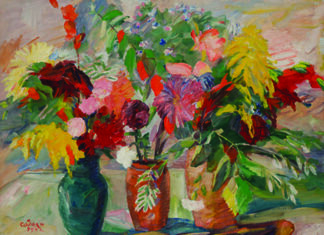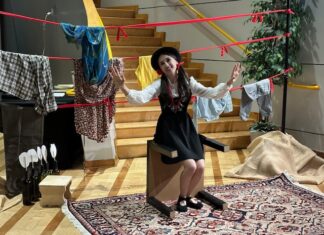By Aram Arkun
Mirror-Spectator Staff
NEW YORK — Ara Oshagan’s photographs all have something askew. Things are viewed from unusual angles, bodies are cut off into torsos, hands or legs appear without bodies and geometric patterns take form. Starkly black and white, his images are intriguing glimpses into people’s lives, illuminated with emotions. Intimate moments, in private or public space, are revealed. Father Land, Oshagan’s first volume of photographs, more than 10 years in the making, appeared at the end of 2010. It is a collaboration with his father Vahé Oshagan, who passed away in 2000. Its Brooklyn-based publisher, powerHouse Books, hosted an exhibition of some 20 photographs from November to December 2010, Oshagan signed books at the International Center of Photography in Manhattan a few weeks later and a larger exhibition, ending this January, was held at the Los Angeles Municipal Art Gallery.
Father Land contains a preface by Vahé Oshagan, the noted poet and writer, in its original Western Armenian, together with an English translation by G. M. Goshgarian, and Ara Oshagan’s images, along with a brief afterword and acknowledgments by Ara Oshagan. In words and photos respectively, the father and son explored in parallel the victorious newly-independent but unrecognized and isolated Republic of Mountainous Karabagh from 1998 to 2006. Vahé’s essay was the last thing he wrote before dying. He wanted to understand as a Diasporan Armenian what Karabagh meant to him, the Armenian identity and to humanity. “Father Land” not only is a literal translation of the Armenian word for homeland, but also refers to the paternal relationship between Vahé and Ara, and Ara’s own fatherhood (he became a father four times over during the course of the preparation of this project).
Vahé Oshagan gives the historical background to Karabagh that can, to a degree, help contextualize his son’s photos. As a paradigmatically transient diasporan, Vahé romanticized what he terms “this ancient, ancestral, magical soil, with the riddle and the secret power of Armenianness.” The Armenian fighters of Karabagh are greater than those elsewhere because of their ties to the land: “What counts, in their case, as the bare minimum of fortitude and audacity is already more than can be reasonably demanded of any other soldier.” “There is no dying in the fatherland,” because you are not alone — your land, family and people perpetuate you. As Vahé describes his travel through Karabagh, both through its history and its present reality, the beauty of the natural landscapes and the churches built by the Armenians impress Vahé as sublime. He sought the secret to the Armenians’ survival in Karabagh in the warlike cruelty of the people, as well as the culture and the tie to the land.
Ara Oshagan explained recently his father was “trying to understand what man is — what is the linkage between history, humanity and soul, these larger issues, through Karabagh.”
Ara Oshagan and his father deliberately did not illustrate one another. He declared, “We did not want one or the other medium to be subservient. We wanted to create a piece of art about this place, allowing the reader to find — or not find — connections.”









